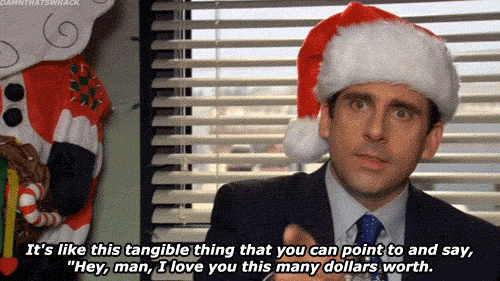Valentine's Consumer Surplus
Yesterday was Valentine’s Day in the States, or as economists call it, “Costly Signaling Day.” I can now call it Consumer Surplus day.
I’m at the store, being a basic Valentine and buying my wife a dozen roses. Later she is going to tell her friend what I did, and her friend is going to say her husband thinks buying flowers are a waste of money. I can’t say I totally disagree, but obviously I’m browsing through various shades of red and pink, so I disagree in some way. But I’m an economist, and I understand signaling theory.
Anyone can say, “I love you.” In economics, we call it cheap talk, meaning that even if you did not love someone you could say it at little personal cost. So how do you prove that you love them? You have to waste money! The more money the better. Someone who was feigning their love wouldn’t be willing to waste money to prove it. Only true love would waste money. Michael Scott understands.
(Note: I think only true love is willing to waste money within a budget; no way am I spending money I don’t have.)
In the store, I finally find a bouquet that signals my love. I look at the price and feel it’s a little high (which I won’t say because I’m embarrassed it might be too low! but keep in mind I was also taking her out to dinner). But at check out, the price came out 30% cheaper! CONSUMER SUPRLUS BABY!!!
Your Assumptions
Last week on my YouTube community tab, I asked for your assumptions about economics. It was great to get your input, and it made for a really good video.
But I won’t put the link here. YouTube does not like when viewers access videos through links: their favorite method is for people to get on YouTube and click on the video from there. So I’m experimenting this week. Go to the YouTube homepage and see if this video pops up for you. If it’s not on your home page, go to Market Power and see if you can find it. If you say, “That’s too much work to watch a video,” then I refer you to the above story about signaling theory. How much do you love this content???
Behavioral Economics and Twitter
If you want to increase your faith in behavioral economics, try adding some nudge-like barriers to curb your addictions. I am a twitter power-consumer. Basically at any moment of down time, I check twitter for updates. I felt this was a hindrance to my productivity, so I asked myself how I could use behavioral economics to reduce my consumption.
The first step was to remove twitter from my phone. That helped, and my spare moments around the house became better. I did find, however, that I started browsing reddit more. Fortunately, it’s not as alluring as twitter.
The next step was to log off of twitter on my work computer. I now only have access to twitter on one computer, a laptop that I use for writing. On the laptop, I installed a browser extension to limit my time to 10 minutes before 6:00 p.m.
How is this behavioral economics? Well, these are relatively minor costs that I’m adding to accessing twitter. My previous usage suggests I’m getting a lot of utility out of twitter, otherwise I wouldn’t have been consuming it as much. If I was truly getting that much utility, than these barriers should do little to change my behavior.
But it has been a huge shift! My consumption is significantly down. I wish I had actual data on my browse time before, but I would not be surprised to learn that I had cut my time on twitter by 90%. My utility from twitter has increased too! In fact, when I get on at night to quickly browse, the experience is so underwhelming I wonder why I checked it so much before.
I guess this shows that behavioral economics truly is the best field. (“Hey! Didn’t you just say that YouTube doesn’t like external links!” Yes, but this is an older video. With new videos I’m trying to give YouTube the best data possible.)





